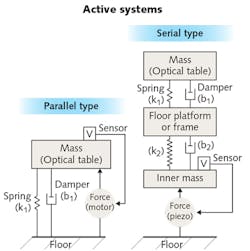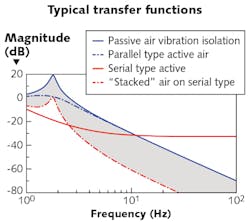Advances in Optical Table Design: Optical table advances quiet vibrations in highly sensitive applications
STEVE RYAN
The backbone of every photonics lab is an optical table. Complex optoelectronic systems require the special properties of optical tables that include stiffness, damping, flatness, cleanliness, tapped hole arrays, and uniform coefficient of thermal expansion. But the most important characteristic is that they provide an extremely quiet and stable work surface.
Optical tables isolate floor vibration by combining an extremely stiff, structurally damped steel honeycomb top with a low-frequency pneumatic vibration isolation support stand. This creates a six degree-of-freedom (DOF) mass-spring-damper system, with the honeycomb top acting as the idealized, infinitely stiff mass and the vibration isolation support stand acting as the damped spring.
A mass-spring-damper has a characteristic resonant frequency (fn) at which it amplifies vibration. Above approximately 1.4 × fn, it begins to isolate and isolation roll-off improves with increasing frequency. The amplification at resonance and the isolation slope are a function of the isolator's damping coefficient. The typical support stand starts to isolate floor vibration above 3–4 Hz. An effective top is very stiff with its first bending mode above 100 Hz and its modes effectively damped by structural dampers mounted inside the honeycomb structure.
With resonant frequencies above 100 Hz, vibration reaching the top through the isolators or other paths is not amplified in the critical frequency range where optoelectronic devices are most sensitive—that is, from 0.5 to 30 Hz. However, vibration damping is not the problem—instead, new optical table designs with stacked isolation supports improve table stability in this critical region by isolating these low-frequency vibrations, allowing even the most sensitive multiphoton imaging and single-molecule biophysics studies to take place.
Damping vs. isolation
Vibration damping and isolation are different characteristics that are often incorrectly used interchangeably. Damping is the conversion of mechanical energy to heat, which applies to both the table-top structure and the vibration isolation support stand. Energy reaching the isolated structure must be dissipated (converted to heat). Mass-spring-dampers built into the table-top structure provide damping for flexing of the top at and above the first bending modes of the top (above 100 Hz). When the optical table system is disturbed, the air isolators are excited at their resonant frequency (1–3 Hz). This motion is dissipated as orifices, dashpots, and other devices built into the air isolators convert this energy to heat.
Isolation, on the other hand, is the reduction of floor vibration reaching the payload achieved by mechanisms in the isolator support stand. Active damping of the top's structure by electromechanical devices built into the top should be considered damping and not isolation, as it does not prevent vibration from reaching the top, but rather damps it.
Historically, improvements to optical table vibration performance have focused on increasing the structural damping of the top-the goal being to combine extremely high stiffness-to-weight ratios achieved with steel honeycomb technology with high structural damping and little amplification at resonance.
In general, this has been successful, with the best tops now achieving critical damping at their lowest resonant frequencies. To the extent that this has had good success, further improvements now provide diminishing returns. Until recently, there have been fewer advances in the isolation systems that support the tops from floor vibration.
The low-frequency isolation challenge
As scientists and engineers seek to make measurements and achieve resolution at ever-smaller scales, optical table applications are increasingly sensitive to low-frequency floor vibration. Such vibration in the 0.5–30 Hz range is not attenuated by even the stiffest and best-damped tops.
Vibration in this frequency range reaching the isolated surface simply results in rigid body motion of the top. Rather, to effectively attenuate vibration in this frequency range, it must be isolated from reaching the top. The best vibration isolation support stands provide limited isolation in this frequency range. They typically consist of passive self-leveling air isolators with low vertical and horizontal resonant frequencies that amplify floor vibration in the 1–4 Hz range and begin to isolate above 4 Hz.
Active feedback control techniques have been applied to optical table vibration isolation supports to improve low-frequency isolation. The term "active" has been used loosely in industry jargon to describe various control systems that include such simple feedback mechanisms as the mechanical self-leveling of air isolators by combining them with pressure regulators and a mechanical linkage.
For clarity, when we refer to "active," we specifically refer to inertial feedback active systems in which the signal from an inertial sensor such as a geophone or accelerometer (which measure velocity or acceleration, respectively) is conditioned, amplified, and ultimately used in closed-loop feedback to cancel unwanted vibration through an electromechanical or other type of actuator.
Inertial feedback active systems
The first embodiments of inertial feedback active systems were parallel-type configurations in which the inertial sensor is mounted to the isolated surface, and the cancellation actuator is mounted in parallel with springs (air isolator supports) that support the isolated surface. This approach can effectively suppress the resonant amplification of the support air isolators in the 1–4 Hz range.
However, attempts to isolate over wide bandwidths with this approach meet with difficulty, as the sensors cannot differentiate between rigid body motion of the top and resonances of structures on the isolated payload. The control system will attempt to cancel both, leading to system instability. While the compromise has been to limit the bandwidth of such systems to <8 Hz, effectively suppressing resonant amplification of the air isolators and improving stability, it does little to improve vibration isolation over the broad 0.5–30 Hz range.
An alternative approach has been developed using a serial-type configuration. Here, the support spring is placed in series with the cancellation actuator. The sensor is mounted to an ultrastiff inner mass that supports the payload through a stiff, 15–20 Hz spring. The actuator supports the inner mass to ground (see Fig. 1).
With this approach, linear motors and other conventional actuators are not feasible because the actuator in a serial-type configuration must support the static weight of the top. But, developments in piezoelectric actuator technology make piezos the ideal choice for serial-type configurations, as they can now be designed to support a large static mass and have excellent response characteristics to very low displacements.
In this embodiment, floor vibration is sensed at the inner mass as it is transmitted through the stiff actuator. The feedback loop is closed at the inner mass as the actuators "filter" floor noise from reaching the inner mass. That is, as the floor moves upward, the actuators contract; as the floor moves downward, they expand.
A three-axis design expands this control behavior to all six DOFs. Such systems are inherently robust, as the payload resonances are filtered from reaching the inner mass by the stiff spring and the sensor is mounted to an inner mass that can be designed to achieve the very high stiffness required—>1000 Hz. Therefore, gain settings can be aggressive with bandwidths of up to 150 Hz frequently achieved, leading to very high levels of vibration attenuation with little risk of instability.
This approach is particularly effective at low frequencies, achieving up to two orders-of-magnitude improvement over passive air isolators in the 1–3 Hz range. In addition, the hard-mount support offers the fringe benefit of maintaining the payload's positional stability with respect to off-board beam sources, which is impractical with a soft-air support.
Though the serial-type approach provides dramatic improvements at very low frequencies, there is little benefit at higher frequencies. Since the passive support spring is much stiffer than a conventional passive air spring, there is less isolation at higher frequencies. In the 10–30 Hz range, serial-type active systems do not provide better vibration attenuation than passive, self-leveling air isolation supports.
Stacked systems for >10 Hz isolation
Always seeking more innovative solutions, scientists have experimented with stacking systems by placing a serial-type active system beneath a passive air isolator. Such systems provide the combined isolation of each sub-system since the transfer functions are additive.
In effect, this approach provides two stages of isolation: one active and one passive. For example, with 30 dB of attenuation at 10 Hz actively and 30 dB of attenuation at 10 Hz passively, 60 dB of total attenuation at 10 Hz is achieved (see Fig. 2). And since the serial-type architecture is an active hard mount, it can be stacked with no risk of instability or crosstalk between the isolation system. The 15–20 Hz hard-mount spring is sufficiently stiffer than the 2 Hz passive air spring to achieve adequate impedance mismatch, ensuring stability.Passive-over-active systems are being adopted for some of the most sensitive applications, including single-molecule biophysics, multiphoton imaging, atomic force microscopy, confocal microscopy, and interferometric studies of large samples where sub-nanometer and even sub-angstrom resolution is desired. As resolution is sought at ever-smaller scales, rapid advances in vibration isolation technology ensure that floor vibration need not be the critical limiting factor.
Steve Ryan is divisional vice president of TMC, a unit of AMETEK Ultra Precision Technologies, Peabody, MA; e-mail: [email protected]; www.techmfg.com.


